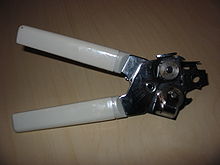Can opener: Difference between revisions
mNo edit summary |
Sarah crane (talk | contribs) -vandalism |
||
| Line 7: | Line 7: | ||
Many variations exist, ranging from those having no moving parts incorporated in many [[pocket knife|pocket knives]] to dedicated electrically-operated [[Small appliance|kitchen appliance]]s. A common type found in many kitchens has a [[pliers]]-like handle used to clamp a cutting wheel against the can's lid and a handgrip that rotates the can to cut the lid around the rim. |
Many variations exist, ranging from those having no moving parts incorporated in many [[pocket knife|pocket knives]] to dedicated electrically-operated [[Small appliance|kitchen appliance]]s. A common type found in many kitchens has a [[pliers]]-like handle used to clamp a cutting wheel against the can's lid and a handgrip that rotates the can to cut the lid around the rim. |
||
The first [[tin can]]s, invented in 1810, were heavy-weight containers that required ingenuity to open, using knives, [[chisel]]s or even rocks. Not until cans started using thinner metal about 50 years later were any dedicated openers developed. [[Ezra Warner]] of [[Waterbury, Connecticut|Waterbury]], [[Connecticut]], [[United States|U.S.]] was first, in 1858, to patent a can opener. The cutting wheel can opener was invented by [[William Lyman (inventor)|William Lyman]] in 1870. The Star Can Company of [[San Francisco]], [[California]] introduced a modified design with a serrated rotating wheel in 1925. The first electric can opener debuted in 1931 |
The first [[tin can]]s, invented in 1810, were heavy-weight containers that required ingenuity to open, using knives, [[chisel]]s or even rocks. Not until cans started using thinner metal about 50 years later were any dedicated openers developed. [[Ezra Warner]] of [[Waterbury, Connecticut|Waterbury]], [[Connecticut]], [[United States|U.S.]] was first, in 1858, to patent a can opener. The cutting wheel can opener was invented by [[William Lyman (inventor)|William Lyman]] in 1870. The Star Can Company of [[San Francisco]], [[California]] introduced a modified design with a serrated rotating wheel in 1925. The first electric can opener debuted in 1931, modeled after the cutting-wheel design. |
||
== See also == |
== See also == |
||
Revision as of 14:45, 11 July 2006
- For the grappling hold, see Spinal lock


A can opener (also known as a tin opener) is a device used to open metal cans.
Many variations exist, ranging from those having no moving parts incorporated in many pocket knives to dedicated electrically-operated kitchen appliances. A common type found in many kitchens has a pliers-like handle used to clamp a cutting wheel against the can's lid and a handgrip that rotates the can to cut the lid around the rim.
The first tin cans, invented in 1810, were heavy-weight containers that required ingenuity to open, using knives, chisels or even rocks. Not until cans started using thinner metal about 50 years later were any dedicated openers developed. Ezra Warner of Waterbury, Connecticut, U.S. was first, in 1858, to patent a can opener. The cutting wheel can opener was invented by William Lyman in 1870. The Star Can Company of San Francisco, California introduced a modified design with a serrated rotating wheel in 1925. The first electric can opener debuted in 1931, modeled after the cutting-wheel design.
